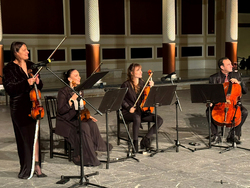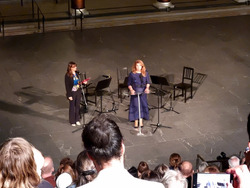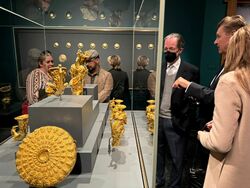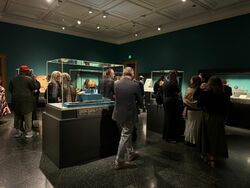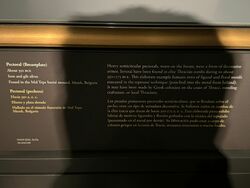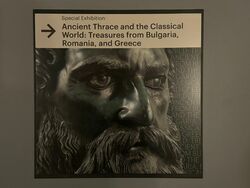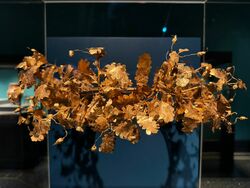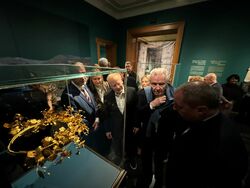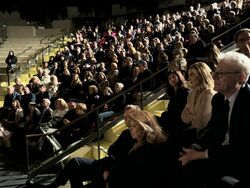site.btaExhibition of Ancient Thracian Treasures from Bulgaria, Romania, and Greece Unveiled in Los Angeles


The exhibition Ancient Thrace and the Classical World: Treasures from Bulgaria, Romania, and Greece, which explores the cultural relations between the Thracians and their neighbors over two millennia, was unveiled on Sunday in Los Angeles.
Shortly after sunset, on the day the United States turned back the clocks an hour to switch to standard time, the amphitheater at Getty Villa in the Los Angeles neighborhood bordering Malibu's Pacific Palisades was filled to capacity with people eager to experience the art of the Thracians.
Ancient Thrace (encompassing present-day Bulgaria and parts of Romania, Greece and Turkiye) was home to a tribal culture whose representatives were renowned for their skills as warriors and horsemen, as well as their wealth in precious metals. The Thracians produced superb gold, silver and bronze wares used for activities as diverse as warfare, riding and banquets. This exhibition features many objects found in Thracian lands that shed light on this little-known culture and its interaction with Ancient Greece, Persia and Rome over two millennia.
The exhibition, which will be displayed until March 3, 2025, includes more than 200 objects, including artfully crafted metalwork in gold, silver and bronze, ceramics, inscriptions, stone reliefs and other works of art showing Thrace and its links with other ancient cultures in the Mediterranean and beyond.
The evening began with string quartet performance of Earth by Bulgarian composer Penka Kouneva, a Grammy winner in 2022's Best Classical Compendium category. It was specially written for the opening of the exhibition and was performed by Bulgarian violinists Blagomira Lipari and Boryana Popova, American violist Ariana Solotoff and Armenian cellist Garik Terzian.
Getty Museum Director Timothy Potts underlined that the exhibition is the third part of The Classical World in Context Program which explores the various forms of interaction linking ancient Greece and Rome with other cultures in the Mediterranean, the Middle East and beyond. The two previous events highlighted the relations of the Classical World with Egypt (2018) and Persia (2022), two cultures which were geographically separated from Greece and Rome, respectively, by the Mediterranean Sea and Syria-Mesopotamia, he added.
Bulgarian Vice President Iliana Iotova said in her opening speech that the exhibition is a dream come true. "God has given man the incredible ability to dream. We were dreaming of announcing, in Bulgarian, the launch of an amazing exhibition right here at the Getty Museum," she added. Iotova stressed that it was important for this exhibition to take place in the Getty Museum because the people in this museum are guardians of knowledge.
Culture Minister Nayden Todorov told BTA that the Thracian culture is one of the things that Bulgaria will be remembered for, which is why it is essential to support Bulgarian culture. He said he was very happy to hear a piece by composer Penka Kuneva at the opening ceremony. According to him, music is the most appropriate way to open an exhibition of Thracian treasures, since the greatest musician of all time, Orpheus, was a Thracian.
Sarah E. Cole, co-curator of the exhibition, told BTA that it is difficult to point out which are the most valuable exhibits, as the exposition includes some very significant groups of materials, among them the Panagyurishte, Rogozen, Valchitran treasures and the bronze head of the Thracian ruler Seuthes III, which is visiting the Getty for the second time. "We feel very proud to be able to bring this archaeological heritage to our audience at the Getty Villa, also very excited and a little bit nervous," she added.
Co-curator Jens Daehner added that there were political and geographical connections in the ancient world and "our job is to show what they were". "History is much more comprehensive to look at Thrace also from the perspective of its neighbours in the ancient world," he added.
After the ceremony, the guests headed in groups to the building, built in the early 1970s, inspired by the architecture of the ancient Roman wealthy suburban houses. As visitors meandered between the marble-floored, green-walled gallery and the designated cocktail area, the talented string quartet continued their performance in the atrium of the Getty Villa.
It is named after J. Paul Getty (1892-1976), an American oil magnate, considered the richest man in the world at the time of his death, according to Encyclopedia Britannica. He owned a controlling stake in the Getty Oil Company and in nearly 200 other concerns. In 1953, he founded the Getty Museum in Malibu, west of Los Angeles, where he displayed many of the art objects he collected during his lifetime. Getty, who died in 1976, bequeathed most of his fortune to the museum's board of trustees. The Getty Trust became a major philanthropic foundation and built the Getty Center, a cultural complex in Los Angeles that opened in 1997.
Bulgaria has major traditions on which the exhibition at the Getty Museum is based. The Bulgarian News Agency (BTA) has been presenting the upcoming exhibition for three weeks now through daily publications in Bulgarian and English. Next year, the Bulgarian News Agency will dedicate an issue of its LIK magazine to Bulgarian archaeology, with the exhibition in Los Angeles being its centrepiece.
According to information from the BTA's Reference Department, about 50 such exhibitions with Bulgarian participation have been held over the past 65 years.
Here's a list of similar exhibitions covered by BTA:
1960, Paris (France): Treasures in Bulgarian Museums and Monasteries
1964, Essen (Germany): Treasures in Bulgarian Museums and Monasteries
1974, Paris (France): Thracian Art from the Bulgarian Lands
1978, Germany, Czechoslovakia, Hungary, Austria: Thracian Art from the Bulgarian Lands
1979, Japan, Germany: Thracian Art from the Bulgarian Lands
1980, Geneva (Switzerland): Thracian Art from the Bulgarian Lands
1981, Stockholm (Sweden): Thracian Art from the Bulgarian Lands
1982, Tokyo (Japan): Europe’s Oldest Civilization and World’s Oldest Gold, Varna, Bulgaria
1983, Moscow, Soviet Union: Troy and Thrace
1986, London (UK): New Thracian Treasure of Rogozen
1987, Montreal (Canada): The Gold of the Thracian Horsemen
1988, Geneva (Switzerland): Treasures of Bulgarian Art from VII to XVI Century
1988, Madrid (Spain): Thracian Treasures
1989, Venice (Italy): The Thracians - Art and Culture in Bulgaria from Prehistory to the Late Roman Age
1989, Saint-Germain-en-Laye (France): Mankind’s First Gold
1997, Uppsala (Sweden): Thracian Treasures
2000, Helsinki (Finland): Thracian Treasures from Bulgaria - World and Statehood
2000, Rome (Italy): Treasures of Christian Art in Bulgaria
2004, Vienna (Austria): Thracian Gold
2004, Bonn (Germany): Thracians. The Golden Kingdom of Orpheus
2005, Barcelona and Madrid (Spain): Thracians. The Enigmatic Treasures of Bulgaria
2006, Valencia (Spain): Thracians. The Enigmatic Treasures of Bulgaria
2006, Rome (Italy): Bulgarian Treasures from the Neolithic to the Middle Ages
2006, Paris (France): Thracian Treasures
2008-2009, Japan: Bulgarian Thracian Treasures
2013, Moscow (Russia): Legends Come to Life. The Thracian Gold of Bulgaria
2015, Paris (France): Saga of the Thracian Kings - Archaeological Discoveries in Bulgaria
2016, Klosterneuburg Monastery (Austria): The Splendour of the East - Christian Art from Bulgaria
2017, Vienna (Austria): The First Gold. Ada Tepe: Europe’s Oldest Gold Mine
2017, Bergen (Norway): Legends in Gold. Thracian Treasures from Bulgaria
2018, Paris (France): The Preslav Treasure. Reflection of the Golden Bulgarian Middle Ages
2022, Bucharest (Romania): The Sveshtari Treasure – Gold of the Thracians South of Danube
2023-2024, Skopje (North Macedonia): Silver Thrace
/MT/
Additional
news.modal.image.header
news.modal.image.text
news.modal.download.header
news.modal.download.text
news.modal.header
news.modal.text













